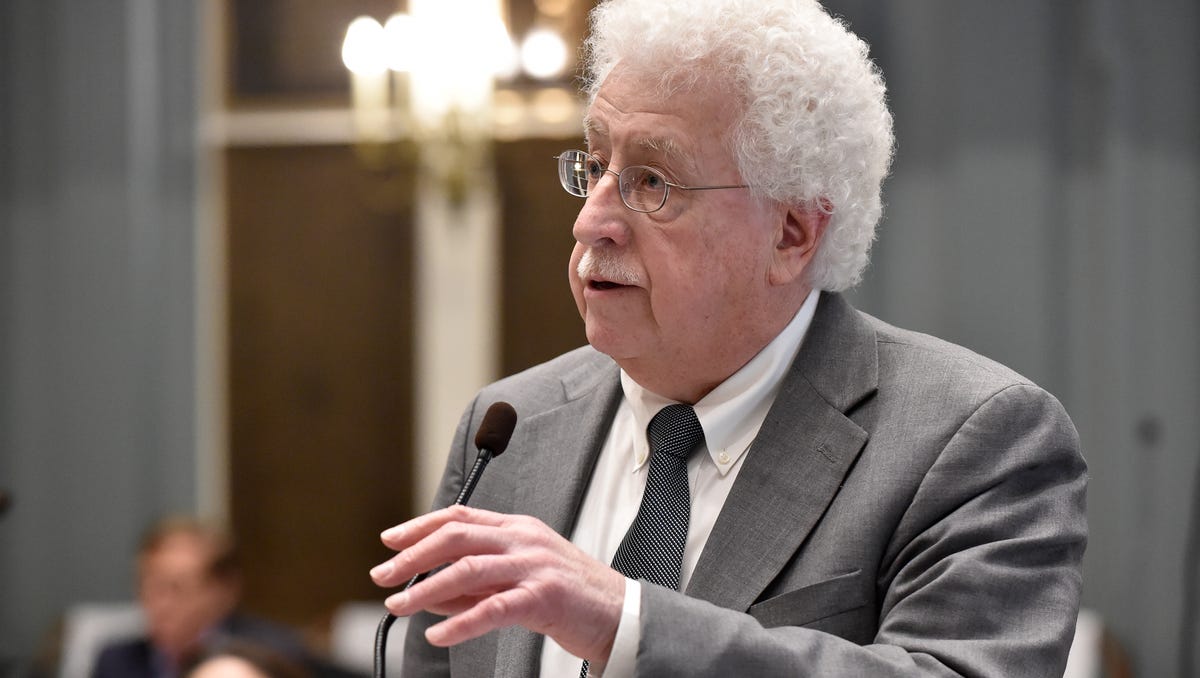Health
Science backers say proposed federal research cuts pose dire risks.

Robert F. Kennedy Jr., the nation’s health secretary, has said that tackling a chronic disease “epidemic” would be a cornerstone of his Make America Healthy Again agenda, often invoking alarming statistics as an urgent reason for reforming public health in this country.
On Friday, President Trump released a proposed budget that called for cutting the funding of the Centers for Disease Control and Prevention by almost half. Its chronic disease center was slated for elimination entirely, a proposal that came as a shock to many state and city health officials.
“Most Americans have some sort of ailment that could be considered chronic,” said Dr. Matifadza Hlatshwayo Davis, health director for the city of St. Louis.
Of the proposed cuts, she said, “How do you reconcile that with trying to make America healthy again?”
The federal health department last month cut 2,400 jobs from the C.D.C., whose National Center for Chronic Disease Prevention and Health Promotion runs on the largest budget within the agency.
Programs on lead poisoning, smoking cessation and reproductive health were jettisoned in a reorganization last month.
Overall, the proposed budget would cut the C.D.C.’s funding to about $4 billion, compared with $9.2 billion in 2024.
The budget blueprint makes no mention of the Prevention and Public Health Fund, a $1.2 billion program. If that figure is taken into account, the cut may be even larger than Mr. Trump’s proposal indicates.
The agency would also lose a center focused on preventing injuries, including those caused by firearms, as well as programs for H.I.V. surveillance and prevention, and grants to help states prepare for public health emergencies.
According to the proposed budget, the cuts are needed to eliminate “duplicative, D.E.I., or simply unnecessary programs.” Congress draws up the federal budget, but given the Republican majority and its fealty to Mr. Trump, it is unclear how much his proposal will change.
C.D.C. officials had been told that the functions of the chronic disease center would be moved to a new organization within the health department called the Administration for a Healthy America.
And the proposal released on Friday appears to allocate $500 million to the health secretary in part “to tackle nutrition, physical activity, healthy lifestyles, overreliance on medication and treatments.”
But at the C.D.C., the chronic disease center’s budget was nearly three times as large. And even if part of the chronic disease center is resuscitated in the A.H.A., it’s unlikely that the new iteration would involve C.D.C. scientists relocated from Atlanta.
“The actual subject-matter experts, who administer the programs, might not be there at C.D.C. anymore,” said Dr. Scott Harris, state health officer at the Alabama Department of Public Health. “We certainly don’t have the same level of expertise in my state.”
The department of Health and Human Services did not respond to a request for comment.
The C.D.C.’s chronic disease center ran programs aimed at preventing cancer, heart disease, diabetes, epilepsy and Alzheimer’s disease. But the center has also seeded initiatives farther afield, ranging from creating rural and urban hiking trails to ensuring that healthy options like salads are offered in airports. It also promoted wellness programs in marginalized communities.
Dr. Davis, the health director in St. Louis, said her department was already reeling from cuts to programs to curb smoking and reduce lead poisoning and health disparities, as well as the rescinding of more than $11 billion that the C.D.C. had been providing to state health departments.
“I would take back Covid-19 in a heartbeat over what’s happening right now,” Dr. Davis said.
In the proposed budget, the administration suggested that the eliminated programs would be better managed by states. But state health departments already manage most chronic disease programs, and three-quarters of the C.D.C. center’s funding goes to support them.
Loss of those funds “would be devastating for us,” said Dr. Harris, the health officer in Alabama.
The state has one of the highest rates of chronic diseases in the country, and about 84 percent of the public health department’s budget comes from the C.D.C., Dr. Harris said. About $6 million goes to chronic disease programs, including blood pressure screening, nutrition education for diabetes and promotion of physical activity.
If those funds were cut, “I am at a loss right now to tell you where that would come from,” he added. “It just seems that no one really knows what to expect, and we’re not really being asked for any input on that.”
Minnesota’s vaunted health department has already laid off 140 employees, and hundreds more may be affected if more C.D.C. funding is lost. Cuts to chronic disease prevention will affect nursing homes, vaccine clinics and public health initiatives for Native Americans in the state.
“The actions of the federal government have left us out on a flimsy limb with no safety net below us,” said Dr. Brooke Cunningham, the state’s health commissioner.
Until recently, “there seemed to be a shared understanding at the local, state and federal level that health was important to invest in,” Dr. Cunningham said.
The C.D.C.’s chronic disease center’s work touches American lives in many unexpected ways.
In Prairie Village, Kan., Stephanie Barr learned about the center 15 years ago when, working as a waitress with no health insurance, she discovered a lump in her breast the size of a lemon.
Through the C.D.C.’s National Breast and Cervical Cancer Early Detection Program, she was able to get a mammogram and an ultrasound, and staff members helped her enroll in Medicaid for treatment after a biopsy determined the lump was malignant, Ms. Barr said.
“It was caught in the nick of time,” said Ms. Barr, now 45 and free of cancer.
Since that program began in 1991, it has provided more than 16.3 million screening exams to more than 6.3 million people with no other affordable access, said Lisa Lacasse, president of the American Cancer Society Cancer Action Network.
The organization is one of 530 health associations that have signed a petition asking lawmakers to reject the proposed H.H.S. budget, which cuts discretionary spending by about one-third. The signatories said the cuts would “effectively devastate” the nation’s research and public health infrastructure.
The budget also proposes dismantling disease registries and surveillance systems.
“If you don’t collect the information or keep these surveillance systems going, you don’t know what’s happening, you don’t know what the trends are,” said Dr. Philip Huang, director of Dallas County Health and Human Services in Texas.
“You’re losing all of that history,” he said.
In a previous position as director of chronic diseases for Texas, Dr. Huang said he worked closely with C.D.C. experts who successfully reduced tobacco use among Americans.
“Eliminating the Office on Smoking and Health is just craziness if you’re still wanting to address chronic diseases,” he said.
Smoking is still the leading cause of preventable death in the United States, causing more than 480,000 deaths each year, according to the C.D.C.
More than one in 10 American adults still smoke cigarettes regularly, but rates vary drastically by region, and C.D.C. surveillance helps target cessation programs to areas where they are needed most.
“Smoking rates have come down, but if the federal government takes its foot off the gas, the tobacco companies are ready to pop back up again,” said Erika Sward, assistant vice president for advocacy at the American Lung Association.
She warned that tobacco companies are constantly developing new products like nicotine pouches, whose use by teenagers doubled last year. “It will take a lot more money to put the genie back in the bottle,” she said.
The C.D.C.’s chronic disease center works with communities and academic centers to promote effective programs, from creating quitting hotlines to reach young Iowans in rural areas to training members of Black churches in Columbia, S.C., to lead exercise and nutrition classes for their congregations.
In rural Missouri, dozens of walking trails have been developed in the “boot heel” in the southeastern part of the state, an area with high rates of obesity and diabetes, said Ross Brownson, a public health researcher at Washington University in St. Louis who directs the Prevention Research Center in collaboration with the C.D.C.
“There’s strong evidence now that if you change the walkability of a community, people will get more physical activity,” Dr. Brownson said. “There aren’t going to be health clubs in rural communities, but there is nature and the ability to have walking trails, and land is relatively cheap.”
With C.D.C. support, in Rochester, N.Y., people who are deaf and hard-of-hearing are being trained to lead exercise and wellness programs for other hearing-impaired people who can’t easily participate in other gym classes.
In San Diego, researchers are testing ways to protect farm workers from exposure to ultraviolet rays and heat-related illnesses.
“Once they are up and started, they are community-driven and don’t depend on the government,” said Allison Bay, who recently lost her job managing such projects at the C.D.C.
The C.D.C.’s reorganization also eliminated lead poisoning programs. Lead poisoning is also “one of our greatest public health threats in the city of Cleveland,” said Dr. David Margolius, director of public health for the city.
The C.D.C. does not directly fund Cleveland’s lead programs — the funding comes from the state. “But just having the federal expertise to call on to help lead us toward a lead-free future, I mean, yeah, that has a big impact on us,” he said.

Health
Ivy League Doctor Shares 5 Surprising Hacks To Balance Blood Sugar

Use left and right arrow keys to navigate between menu items.
Use escape to exit the menu.
Sign Up
Create a free account to access exclusive content, play games, solve puzzles, test your pop-culture knowledge and receive special offers.
Already have an account? Login
Health
Why cancer is hitting the Midwest harder than anywhere else in America

NEWYou can now listen to Fox News articles!
While the rest of the country’s cancer rates are falling, those in Iowa, Nebraska, Illinois, Minnesota, Indiana and Kansas — known as the Corn Belt — are rising at an alarming rate, data shows.
The spike in America’s corn-producing states caught the attention of the University of Iowa’s Holden Comprehensive Cancer Center, which gathered a panel to investigate the trend.
One of the experts, Dr. Marian Neuhouser, a professor at the Fred Hutchinson Cancer Center in Seattle, served on the panel as an expert in nutrition and obesity.
COLORECTAL CANCER MAY CAUSE THESE 4 HIDDEN WARNING SIGNS, EXPERTS SAY
“The panel came about after they noticed that the trends for cancer incidence were increasing at a faster rate in Iowa than in other states,” Neuhouser told Fox News Digital.
A data analysis by The Washington Post based on federal health datasets found that the number of people diagnosed with cancer in the six Corn Belt states has outpaced the national average since the mid-2010s.
While the rest of the country’s cancer rates are falling, those in the Corn Belt states — Iowa, Nebraska, Illinois, Minnesota, Indiana and Kansas — are rising at an alarming rate. (iStock)
In 1999, cancer rates in the Midwest were on par with the national average. Now, among residents aged 15 to 49, those rates are about 5% higher, a pattern that began diverging in the 2000s and has steadily widened.
The Post based its findings on data from the National Cancer Institute and the Centers for Disease Control and Prevention, which track cancer incidence nationwide.
RISK OF COLON CANCER SLASHED BY EATING SPECIFIC TYPES OF VEGETABLES, STUDY FINDS
The analysis compared rates from 1999 through 2022 using multi-year averages for Iowa and excluding 2020 due to pandemic disruptions.
Experts probe causes
Neuhouser noted that some of the increases involve cancers that are preventable or detectable through screening.
Researchers are examining both environmental and lifestyle factors that could be driving the increase.

A panel of experts convened in Iowa after more numbers came out about the alarming spike in cancer rates. (iStock)
Outdoor UV exposure and high rates of binge drinking could be contributors, according to the Iowa Cancer Registry, part of the National Institutes of Health’s surveillance network.
Iowa’s Environmental Health Sciences Research Center has described the state as a “hot spot for environmental exposures to carcinogenic agents.”
CANCER DEATHS HIT ‘ALARMING’ SURGE DUE TO COMMON HEALTH CONDITION, EXPERTS SAY
The soil and groundwater in the region reportedly contain some of the nation’s highest levels of natural radon and nitrate, largely because of fertilizer use in farming. Both substances have been linked to high risks of lung and gastrointestinal cancers.
Meanwhile, the widespread application of pesticides and herbicides, including glyphosate, continues to generate debate among scientists and regulators.

Where fields once symbolized abundance, they now raise questions about how the chemicals used to maintain them could affect people’s health. (iStock)
Risk of chemical exposure
Dr. Anne McTiernan, professor of epidemiology at the Fred Hutchinson Cancer Center in Seattle, has analyzed decades of research on glyphosate and cancer risk.
“Glyphosate, a broad-spectrum herbicide, has been used in the U.S. for decades and is reported to be the most widely used pesticide globally,” she told Fox News Digital.
CLICK HERE TO DOWNLOAD THE FOX NEWS APP
The World Health Organization’s International Agency for Research on Cancer classified glyphosate as “a 2A carcinogen (“probably carcinogenic to humans”), which is the second-highest grade of carcinogen, according to McTiernan.
CLICK HERE TO SIGN UP FOR OUR HEALTH NEWSLETTER
Her review of studies through 2025 found that people with long-term, high exposure to glyphosate, such as those working on farms, had a roughly 40% higher risk of developing non-Hodgkin lymphoma compared to those who were never exposed.

Researchers warn that the causes of cancer spikes in the Corn Belt may lie in decades of invisible exposure. (iStock)
This level of increased risk, combined with lab evidence that glyphosate can damage DNA and cause cellular stress, is considered strong enough to support a causal link, according to the expert.
TEST YOURSELF WITH OUR LATEST LIFESTYLE QUIZ
Role of obesity and alcohol
Lifestyle factors are also compounding risk. Per CDC data, about 21% of Iowa adults report heavy drinking or binge drinking, compared to roughly 17% nationally.
The Iowa Department of Health and Human Services reports that about 35% of adults in the state are classified as obese, placing it among 19 states with obesity prevalence at or above that level. Nationwide, the CDC reports an adult obesity rate of roughly 40%.
CLICK HERE FOR MORE HEALTH STORIES
Neuhouser noted that 13 separate cancers are linked to obesity.
“Everyone would like to be able to narrow down cancer risk … to one exposure, but cancer is so complex that it’s usually several factors working together,” she said.
Health
11 Simple Hacks Real Women Used to Lose Weight

Use left and right arrow keys to navigate between menu items.
Use escape to exit the menu.
Sign Up
Create a free account to access exclusive content, play games, solve puzzles, test your pop-culture knowledge and receive special offers.
Already have an account? Login
-

 New York1 week ago
New York1 week agoVideo: How Mamdani Has Evolved in the Mayoral Race
-

 News1 week ago
News1 week agoVideo: Federal Agents Detain Man During New York City Raid
-

 News1 week ago
News1 week agoBooks about race and gender to be returned to school libraries on some military bases
-

 News1 week ago
News1 week agoVideo: Driver Crashes Car Into Security Gate Near White House
-

 News1 week ago
News1 week agoVideo: Inside Our Reporter’s Collection of Guantánamo Portraits
-

 Politics1 week ago
Politics1 week agoHunter Biden breaks silence on pardon from dad Joe: ‘I realize how privileged I am’
-

 Politics1 week ago
Politics1 week agoJack Smith defends subpoenaing Republican senators’ phone records: ‘Entirely proper’
-

 World1 week ago
World1 week agoTrump to host NATO chief at White House as Putin meeting collapses


















